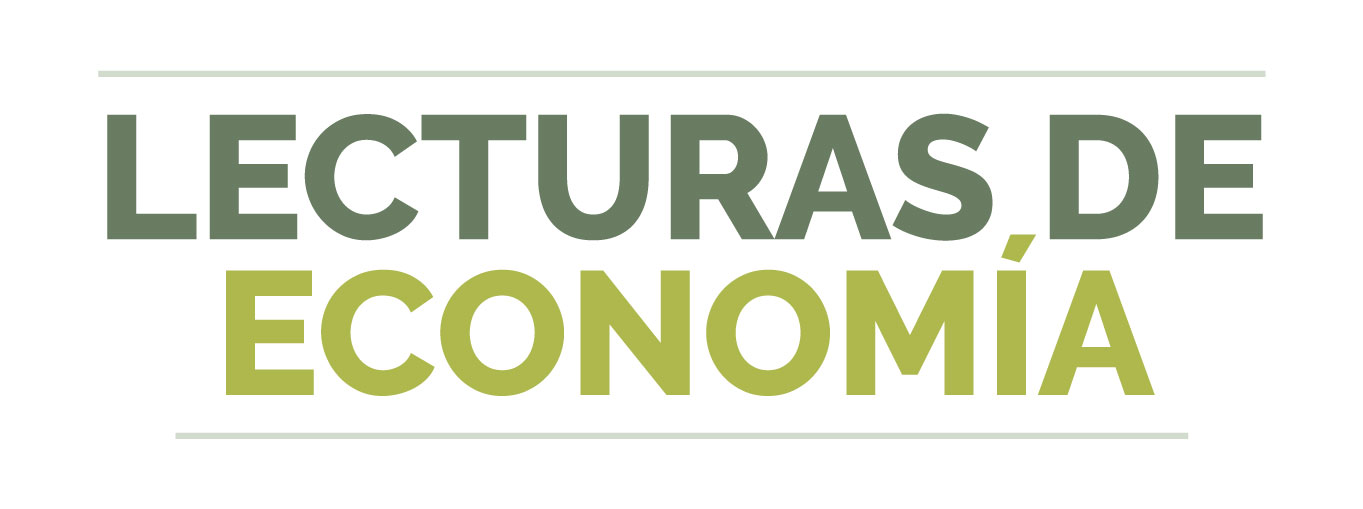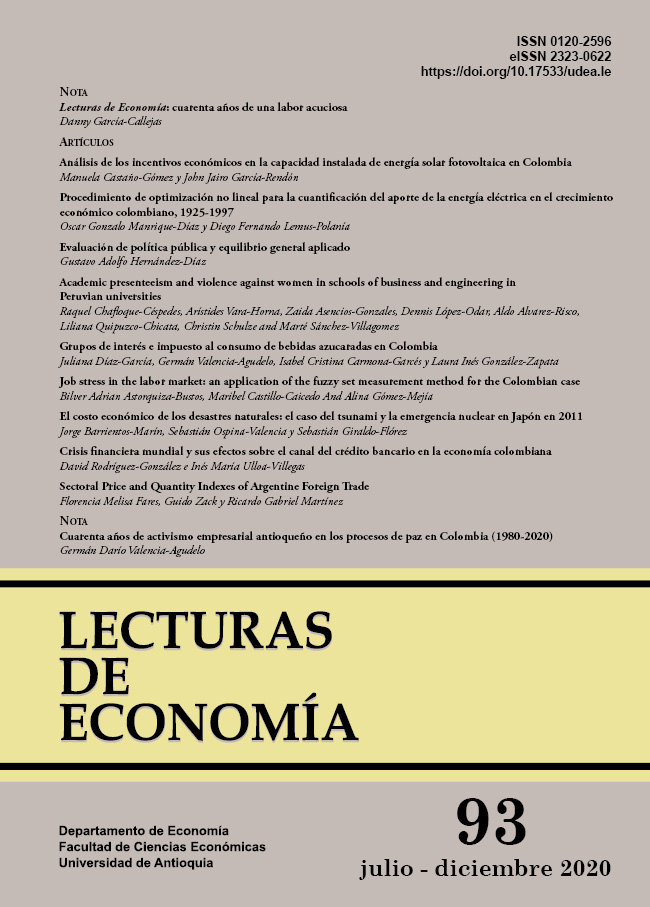Assiduité scolaire et violence contre les femmes dans les écoles de commerce et d'ingénieurs dans les universités péruviennes
DOI :
https://doi.org/10.17533/udea.le.n93a340726Mots-clés :
assiduité scolaire, violence contre les femmes, relations avec les partenaires intimes, universitéRésumé
L'objectif de cette étude est démontrer le rapport entre la violence contre les femmes (VCM) en ce qui concerne les relations avec leurs partenaires intimes et l'assiduité scolaire des élèves inscrits à des programmes d'affaires et de l'ingénierie, dans les universités péruviennes. Cette étude a adopté un plan d'enquête transversale exploratoire auprès de 2640 étudiants des écoles de commerce et d'ingénieurs dans 34 universités péruviennes. On a constaté que 96,5% des étudiants enquêtés ont déclaré avoir assiduité, tandis que le 32,0% sont des survivants de la VCM. La régression par des moindres carrés partiels montre que la VCM provoque 8,47 jours scolaires perdus à l'université, ceux qu’en même temps entraîne 15,12 disputes avec les enseignants et les collègues étudiants, au cours de l'année scolaire. Enfin, il a été démontré que la VCM explique un 7,2% de l’assiduité des étudiants universitaires. Cette étude est parmi les très rares recherches qui explorent l'emploi du temps des élèves dans une même journée. Nous avons donc la quantité d’heures productives académiques des étudiants universitaires au Pérou.
Téléchargements
Références
Adams, A. E., Greeson, M. R., Kennedy, A. C. & Tolman, R. M. (2013). The effects of adolescent intimate partner violence on women’s educational attainment and earnings. Journal of Interpersonal Violence, 28(17), 3283-3300.
Asante, F., Fenny, A., Dzudzor, M., Chadha, M., Scriver, S., Ballantine, C. & Duvvury, N. (2019). Economic and Social Costs of Violence Against Women and Girls in Ghana: Country Technical Report. Irlanda: Galway NUI.
Chafloque-Céspedes, R., Vara-Horna, A., Lopez-Odar, D., Santi-Huaranca, I., Diaz-Rosillo, A. & Asencios-Gonzalez, Z. (2018). Ausentismo, presentismo y rendimiento académico en estudiantes de universidades peruanas. Propósitos y Representaciones, 6(1), 83-133.
Chan, K., Straus, M., Brownridge, D., Tiwari, A. & Leung, W. (2008). Prevalence of dating partner violence and suicidal ideation among male and female University Students Worldwide. Journal of Midwifery & Women´s Health, 53(6), 529-537. http://doi.org/10.1016/j.jmwh.2008.04.016
Deroma, V., Leach, J. & Leverett, J. (2009). The relationship between depression and college academic performance. College Student Journal, 43(2), 325-335.
Duvvury, N., Callan, A., Carney, P. & Raghavendra, S. (2013). Intimate partner violence: Economic costs and implications for growth and development (Women’s Voice, Agency, & Participation Research Series, No. 3). https://openknowledge.worldbank.org/bitstream/handle/10986/16697/825320WP0Intim00Box379862B00PUBLIC0.pdf?sequence=1
Edwars, K., Dardis, C., Sylaska, K. & Gidycz C. A. (2015). Informal social reactions to college women´s disclosure of intimate partner violence: Associations with psychological and relational variables. Journal of Interpersonal Violence, 30(1), 25-44. http://doi.org/10.1177/0886260514532524
Elmusharaf, K., Scriver, S., Chadha, M., Ballantine, C., Raghavendra, S., Sabir, M., Duvvury, N., Kennedy, J., Grant-Vest, S. & Edopu, P. (2019). Economic & social costs of VAWG violence against women & girls South Sudan. Retrieved from: https://www.whatworks.co.za/resources/reports/item/594-economic-and-social-costs-of-violence-against-women-in-south-sudan-technical-report
Ferritto, V. (2013). Presenteeism, participation in a worksite wellness program, and employee income and education: a correlational quantitative study of workers in the New York Designated Market Area (NYDMA) (Dissertation, Capella University, UMI 3593082).
Ferritto, V. (2016). Maritime education factors and presenteeism: A comparative quantitative study. WMU Journal of Maritime Affairs, 15(2), 353-380. http://doi.org/10.1007/s13437-015-0098-9
Galliker, S., Nicoletti, C., Feer, S., Etzer-Hofer, I., Brunner, B., Grosse Holtforth, M., Melloh, M., Dratva, J. & Elfering, A. (2020). Quality of leadership and presenteeism in health professions education and research: a test of a recovery-based process model with cognitive irritation and impaired sleep as mediators. Psychology, Health & Medicine, 25(2), 239-251.
GIZ (Deutsche Gesellschaft für Internationale Zusammenarbeit) (2015). Los costos empresariales de la violencia contra las mujeres en Paraguay. Asunción, Paraguay: AGR SA Servicios Gráficos.
Hemp, P. (2004). Presenteeism: At work - but out of it. Harvard Business Review, 82(10), 49-58.
Herrera, J. M. & Arena, C. A. (2010). Consumo de alcohol y violencia doméstica contra las mujeres: un estudio con estudiantes universitarias de México. RLAE, 18(559), 557-564.
Hossain, M., Memiah, P. & Adeyinka, A. (2014). Are female college students who are diagnosed with depression at greater risk of experiencing sexual violence on college campus? Journal of Health Care for the Poor and Underserved, 25(3),1341-1359. http://doi.org/10.1353/hpu.2014.0146
Johns, G. (2011). Attendance dynamics at work: the antecedents and correlates of presenteeism, absenteeism, and productivity loss. Journal of Occupational Health Psychology, 16(4), 483-500. http://doi.org/10.1037/a0025153
Jordan, C., Combs, J. & Smith, G. (2014). An Exploration of Sexual Victimization and Academic Performance Among College Women. Sage Journal, 15(3), 131-200. http://doi.org/10.1177/1524838014520637
Lerner, D., Amick III, B., Rogers, W., Malspeis, S., Bungay, K. & Cynn, D. (2001). The work limitations questionnaire. Medical Care, 39(1), 72-82.
Logan, T., Walker, R. & Hoyt, W. (2012). The economic costs of partner violence and the cost-benefit of civil protective orders. Journal of Interpersonal Violence, 27(6), 1137-1154. http://doi.org/10.1177/0886260511424500
Matsushita, M., Adachi, H., Arakida, M., Namura, I., Takahashi, Y., Miyata, M. & Sugita, Y. (2011). Presenteeism in college students: Reliability and validity of the presenteeism scale for students. Quality of Life Research, 20(3), 439-446. http://doi.org/10.1007/s11136-010-9763-9
Mengo, C. & Beverly, M. (2015). Violence victimization on a college campus. Impacts on GPA and school dropout. Journal of College Student Retention: Research, Theory & Practice, 18(2), 234-248. http://doi.org/10.1177/1521025115584750
Merrill, R., Aldana, S., Pope, J., Anderson, D., Coberley, C. & Whitmer, R. (2012). Presenteeism according to healthy behaviors, physical health, and work environment. Population Health Management, 15(5), 293-301. http://doi.org/10.1089/pop.2012.0003
Mikami, A., Matsushita, M., Adachi, H., Suganuma, N., Koyama, A., Ichimi, N. & Sugita, Y. (2013). Sense of coherence, health problems, and presenteeism in japanese university students. Asian Journal of Psychiatry, 6(5), 369-372. http://doi.org/10.1016/j.ajp.2013.03.008
Miller, E. (2017). Prevention of and interventions for dating and sexual violence in adolescence. Pediatric Clinics of North America, 64(2), 423-434 http://doi.org/10.1016/j.pcl.2016.11.010
Phipps, A. & Smith, G. (2012). Violence against women students in the UK: Time to take action. Gender and Education, 24(4), 357-373. http://doi.org/10.1080/09540253.2011.628928
Reeves, C. & O´Leary-Kelly, A. (2007). The effects and costs of intimate partner violence for work organizations. Journal of Interpersonal Violence, 22(3), 327-344. http://doi.org/10.1177/0886260506295382
Rennison, C. & Addington, L. (2014). Violence against college women: A review to identify limitations in defining the problem and inform future research. Trauma, Violence, and Abuse, 15(3), 159-169. http://doi.org/10.1177/152483801452072
Rubio-Garay, F., López-Gonzáles, M. & Sánchez-Elvira-Paniagua, A. (2012). Directionality and violence expression in dating relationships of young people. Acción Psicológica, 9(1), 61-70. http://doi.org/10.5944/ap.9.1.437
SPDC (Social Policy and Development Centre), NUI Galway, Ipsos Mori & ICRW (International Centre for Research on Women) (2019). Economic and Social Costs of Violence against Women in Pakistan: Summary Report April 2019. Irlanda, Galway NUI. 32p.
Stewart, W., Ricci, J., Chee, E., Hann, S. & Morganstein, D. (2003). Cost of lost productive work time among US workers with depression. Journal of the American Medical Association, 289(23), 3135-3144. http://doi.org/10.1001/jama.289.23.3135
Straus, M., Hamby, S., Boney-McCoy, S. & Sugarman, D. (1996). The revised conflict tactics scales (CTS) development and preliminary psychometric data. Journal of Family Issues, 17(3), 283-316.
Swanberg, J. E., Macke, C. & Logan, T. K. (2006). Intimate partner violence, women, and work: Coping on the job. Violence and Victims, 21(5), 561-578.
Umana, J., Fawole, O. & Adeoye, I. (2014). Prevalence and correlates of intimate partner violence towards female students of the university of Ibadan, Nigeria. BMC Women’s Health, 14(131). http://doi.org/10.1186/1472-6874-14-131
University of Limerick & NUI Galway (2019). Economic and Social Costs of Violence Against Women in South Sudan: Summary Report. Irlanda, Galway: NUI Galway. https://www.ipsos.com/sites/default/files/ct/publication/documents/2019-07/economic-social-costs-violence-women-girls-south-sudan-2019.pdf
Valls, R., Puigvert, L., Melgar, P. & García-Yeste, C. (2016). Breaking the silence at Spanish universities: Findings from the first study of violence against women on campuses in Spain. Violence Against Women, 22(13), 1519-1539. http://doi.org/10.1177/1077801215627511
Vänni, K., Neupane, S. & Nygård, C. (2017). An effort to assess the relation between productivity loss costs and presenteeism at work. International Journal of Occupational Safety & Ergonomics, 23(1), 33-43. http://doi.org/10.1080/10803548.2016.1197578
Vara-Horna, A. (2015). Los costos empresariales de la violencia contra las mujeres en Bolivia. Una estimación del impacto invisible para la productividad de la violencia contra las mujeres en relaciones de pareja. La Paz, Bolivia: Agencia de Cooperación Alemana GIZ.
Vara-Horna, A., Santi, I., Asencios-Gonzalez, Z. & Lescano, G. (2017). Impacto de la violencia contra las mujeres en el desempeño laboral docente en la Región Callao - Perú. Lima, Perú: Universidad de San Martín de Porres.
Vázquez, F., Torres, A., Otero, P., Blanco, V. & López, M. (2010). Prevalence and risk factors of violence against women among spanish female university students. [Prevalencia y factores de riesgo de la violencia contra la mujer en estudiantes universitarias españolas]. Psicothema, 22(2), 196-201.
Wang, J., Schmitz, N., Smailes, E., Sareen, J. & Patten, S. (2010). Workplace characteristics, depression, and health-related presenteeism in a general population sample. Journal of Occupational and Environmental Medicine, 52(8), 836-842. http://doi.org/10.1097/JOM.0b013e3181ed3d80
Yoshida, M. & Miki, A. (2018). Factors Related to Presenteeism in Young and Middle-aged Nurses. Sangyo Eiseigaku Zasshi (Journal of Occupational Health), 60(2), 31-40. http://doi.org/10.1539/sangyoeisei.17-019-b
Téléchargements
Publié-e
Comment citer
Numéro
Rubrique
Licence
(c) Tous droits réservés Raquel Chafloque-Cespedes, Aristides Vara-Horna, Zaida Asencios-Gonzales, Dennis Rolando López-Odar, Aldo Alvarez-Risco, Liliana Quipuzco-Chicata, Christin Schulze, Marte Sanchez-Villagomez 2020

Cette œuvre est sous licence Creative Commons Attribution - Pas d'Utilisation Commerciale - Partage dans les Mêmes Conditions 4.0 International.
Cette page, par Universidad de Antioquia, est autorisée sous une Licence d'attribution Creative Commons.
Les auteurs qui publient avec cette revue acceptent de conserver les droits d'auteur et d'accorder le droit de première publication à la revue, l'article sous licence sous une licence Creative Commons Attribution-NonCommercial-ShareAlike permettant à d'autres de le partager tant qu'ils reconnaissent sa paternité et sa publication originale dans ce journal.
Les auteurs peuvent conclure des accords contractuels supplémentaires et distincts pour la distribution non exclusive de la version publiée de la revue (par exemple, la publier dans un référentiel institutionnel ou la publier dans un livre), à condition que ces accords soient sans but lucratif et être reconnu comme la source originale de publication.
Les auteurs sont autorisés et encouragés à publier leurs articles en ligne (par exemple, dans des dépôts institutionnels ou sur leurs sites Web), car cela peut conduire à de précieux échanges ainsi qu'à une plus grande citation des travaux publiés.









